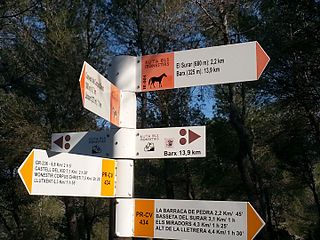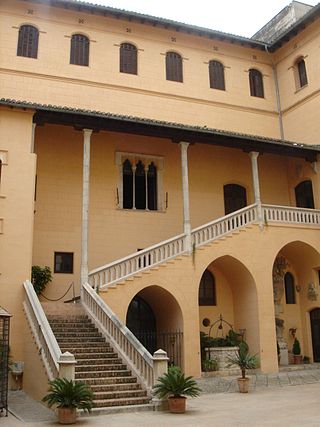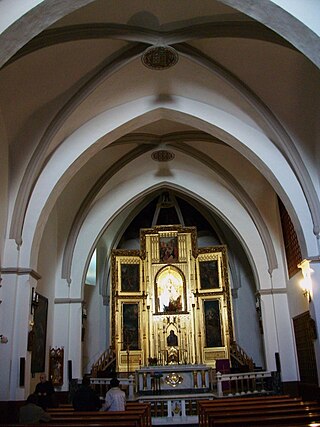
Gandia is a city and municipality in the Valencian Community, eastern Spain on the Mediterranean. Gandia is located on the Costa del Azahar, 65 kilometres (40 mi) south of Valencia and 110 km (68 mi) north of Alicante. Vehicles can access the city through road N-332.

Francis Borgia was a Spanish Jesuit priest. The great-grandson of both Pope Alexander VI and King Ferdinand II of Aragon, he was Duke of Gandía and a grandee of Spain. After the death of his wife, Borgia renounced his titles and became a priest in the Society of Jesus, later serving as its third superior general. He was canonized on 20 June 1670 by Pope Clement X.

Manuel Zeno Gandía was a Puerto Rican physician, poet, novelist, journalist and politician. He is best known as the author of La Charca, a novel considered by many to be the first Puerto Rican novel.

Mission Santa María de los Ángeles was the last of the missions established by the Jesuits in Baja California, Mexico, in 1767. The mission was named after Saint Maria of the Angels, as well as after Maria Ana Antonia Luisa de Borja-Centelles y Fernández de Córdoba, Duchess of Gandía, who donated money to the Baja California missions in 1747.

The Technical University of Valencia, shortened to UPV, is a Spanish university located in Valencia, with a focus on science, technology, and arts. It was founded in 1968 as the Higher Polytechnic School of Valencia and became a university in 1971, but some of its schools are more than 100 years old.

Alphonsus Rodríguez was a Spanish Jesuit religious brother who is venerated as a saint in the Catholic Church.
Misión San Francisco Borja de Adac was a Spanish mission established in 1762 by the Jesuit Wenceslaus Linck at the Cochimí settlement of Adac, west of Bahía de los Ángeles. The mission was named after Francis Borgia, 4th Duke of Gandía.

The Ajacán Mission was a Spanish attempt in 1570 to establish a Jesuit mission in the vicinity of the Virginia Peninsula to bring Christianity to the Virginia Native Americans. The effort to found St. Mary's Mission predated the founding of the English settlement at Jamestown, Virginia, by about 36 years. In February 1571, the entire party was massacred by Indians, except for Alonso de Olmos. The following year, a Spanish party from Florida went to the area, rescued Alonso, and killed several Indians.
Palma de Gandia is a municipality in the comarca of Safor in the Valencian Community, Spain.
El Real de Gandia is a municipality in the comarca of Safor in the Valencian Community, Spain.

Duke of Gandía is a title of Spanish nobility that was first created in 1399 by Martin of Aragon and granted to Alfonso of Aragon and Foix. It has its origin in the lordship of Gandía created in 1323 by James II of Aragon. Later, having no direct descendants, the title passed from the House of Barcelona to the House of Trastámara.

The Route of the Monasteries of Valencia (GR-236) is a religious and cultural route that connects five monasteries located in central region of the Province of Valencia,, in Spain. The Route was inaugurated in the year 2008.

Juan de Borja y Castro was a Spanish noble of the House of Borja and the House of Castro. Juan was a soldier, diplomat and a worker for the Spanish state. He is best known for being the first Count of Mayalde and count consort of Ficalho.

The Route of the Borgias is a cultural route, that includes sites associated with the Borja or Borgia, located in their native Valencian Community, Spain. The marketing of the route was inaugurated in 2007.

The Ducal Palace of Gandia was, from the 14th century, the residence of the Royal Dukes of Gandía, and from 1485, the Borja family. It was the birthplace of Saint Francis Borja.

The Collegiate Basilica of Santa Maria of Gandia, also known as "La Seu", is the principal church of the city of Gandia, (Valencia). Construction commenced in the 14th century.

The Convent of Santa Clara is 15th-century, Roman Catholic convent belonging to cloistered order of the Colettine Poor Clares, and located in the town of Gandia, province of Valencia, Spain. It is located in the centre of Gandia and at few meters from the Collegiate Basilica of Gandia, in María Enríquez de Luna square.

The Route of the Valencian classics,, is a cultural route through the lands of the great classical writers of the Valencian literature of the Valencian Golden Age: Ausiàs March, Joanot Martorell and Joan Roís de Corella, the three related to the court of the Duke Alfonso of Aragon and Foix, "the Old".

Valencian Gothic is an architectural style. It occurred under the Kingdom of Valencia between the 13th and 15th centuries, which places it at the end of the European Gothic period and at the beginning of the Renaissance. The term "Valencian Gothic" is confined to the Kingdom of Valencia and its area of influence, which has its own characteristics.

Diana Morant Ripoll is a Spanish politician who has been Minister of Science and Innovation since 12 July 2021. She has been Secretary-General of the Socialist Party of the Valencian Country since 2014 and Mayor of Gandia (Valencia) from June 2015 until July 2021. She was also member of the Corts Valencianes, the regional assembly of the Valencia region, from July 2015 to May 2017. She started her political career in the Spanish Socialist Workers Party (PSOE) on 11 June 2011.


















